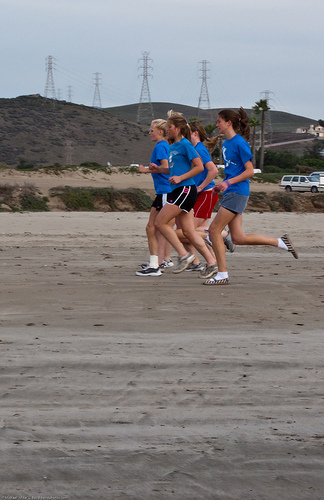Running Injuries
 They run for fun in the hot, hot sun. Oh me! Oh my! -Dr. Seuss
They run for fun in the hot, hot sun. Oh me! Oh my! -Dr. Seuss
I happily report more kids are participating in organized athletics each year. However, a natural consequence of increasing participation is an increase in injuries. We are only a few weeks into the fall sport season and I am already seeing running injuries in the office.
The beginning of the sports season is a common time to see an increase in running injuries due to a quick increase in milage, intensity, and frequency of running. Running injures are common due to the repetitive nature of the sport. In addition, younger children have an immature musculoskeletal system that is growing and changing. There is a higher risk of injury at immature sites of tendon insertion, growth plates, and associated joint surfaces during athletic participation.
A quick anatomy lesson will help explain. The musculoskeletal system is a complex arrangement of bones and muscles to allow the body's movement. In a growing body, the bones have areas of actively dividing cells to increase a bone's length. These areas are called growth plates. Muscles are attached to bones by tendons. Tendons have similar areas of dividing cells called apophyses. As a person ages, the apophyses are slowly replaced by bone. Both growth plates in bones and apophyses near tendons are areas of relative weakness compared to mature bones and muscles that are not growing. It is in these areas, therefore, that young athletes are more susceptible to injury.
The vast majority of running injuries are due to overuse. Overuse injuries are due to a combination of an excessive amount of activity and stress on the musculoskeletal system without appropriate time to recover from the stress of practice and play. There have been reports analyzing the injuries in high school cross country runners. The most common area of injury in females is the shins. In boys, the most frequent area if injury is the knee. In addition, researchers have determined that once an area is injured, there is a significantly increased risk of reinjury to the same area.
How can parents and coaches decrease the rate of injuries in their athletes? The American Academy of Pediatrics has some suggestions to decrease overuse injuries in young athletes. These tips include:
- Encourage athletes to strive to have at least 1 to 2 days off per week from competitive athletics, sport-specific training, and competitive practice (scrimmage) to allow them to recover both physically and psychologically.
- Advise athletes that the weekly training time, number of repetitions, or total distance should not increase by more than 10% each week (eg, increase total running mileage by 2 miles if currently running a total of 20 miles per week).
- Encourage the athlete to take at least 2 to 3 months away from a specific sport during the year.
- Emphasize that the focus of sports participation should be on fun, skill acquisition, safety, and sportsmanship.
- Encourage the athlete to participate on only 1 team during a season. If the athlete is also a member of a traveling or select team, then that participation time should be incorporated into the aforementioned guidelines.
- If the athlete complains of nonspecific muscle or joint problems, fatigue, or poor academic performance, be alert for possible burnout. Questions pertaining to sport motivation may be appropriate.
I plan on addressing specific, common injuries in future posts. Until then... play smart, play safe, and play well!
P.S. Here is a link to a great site for your teen to read about running safety. Have them check it out!
